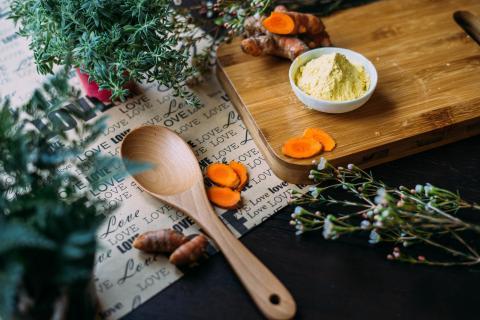
Join Basmati.com every week for a Q&A session with one of Basmati’s practitioners, Melissa Hill (FDN-P)! We know that there is a lot of confusing information out there, which can make applying health advice overwhelming. Sometimes, it’s best to ask a practitioner directly, so each week we’ll cover a common health question!
Do you have a health question you’d like to ask? Write to us at editors [at] basmati [dot] com and your question could be chosen and featured in a future column!
Q: I know Turmeric is good for inflammation and a lot of other things….but HOW do I take it? What is the best way?
A: That’s right – turmeric is amazing and has numerous health benefits, most notoriously its ability to combat inflammation in our bodies. I am a big fan of using food as medicine (because it is)! Turmeric is a root, so it is a food – and can be consumed like one. That means you can cook with it, grate it up and cook it into your dishes like these, or buy it already ground up and dried in powder form, usually found in the spice section at your local health food store or food co-op. It can be made into a tea by steeping it in hot water or making into Golden Milk for a delicious way to drink this amazing root.
Q: But how much is enough? One capsule a day? Two tablespoons?
A: That is a good question – and the answer is: it depends. It depends on what your desired outcome is and what your health situation is. For general health purposes, I would say consume some turmeric every day. General recommendations are 1 to 3 grams a day as a long term health-promoting dose that most everyone would benefit from. That could be about 2 capsules to get in 1 gram (1000mg) or ½ teaspoon of dried powder, which is about 1600mg, that you can mix into your food or beverages.
Q: And HOW do you take it?
A: If you have a particular inflammation issue you are trying to rectify (either acute injury or chronic inflammatory process), then usually a much larger dose would be effective. So, instead of 1,000mg a day, a dose of 1,000-3,000mg a few times a day or in one large dose would likely be more effective. Turmeric has been studied and shown safe to be taken at doses as large as 8-12g per day for a few months. So, you could consume this amount in one dose of a Tablespoon of powder stirred into hot water or a teaspoon at a time 3 times a day. I personally don’t mind the taste just mixing it with a small amount of water and drinking it down. If this is not appealing to you, you can make it into more of a latte like beverage with warm milk of your choice, a little honey, coconut oil, vanilla, and cinnamon. You can also cook it right into your food with some ghee or coconut oil in things like rice, potatoes, eggs, greens, etc. For more suggestions on how to get more turmeric in your diet, see here. If eating 3 -4 teaspoons of turmeric seems like a lot to stomach to you, you might be better off using the capsules or tablets. This is not as cost effective, but it is more convenient. Another factor is your ability to digest it. If your stomach has trouble with one large dose, you might be better off spacing it out every few hours and combining it with food. Ideally, digestive enhancing aids like ginger and black pepper can help as well as heating it with some healthy fat like ghee or coconut oil to increase its absorption and help its delivery to the deeper tissue layers of your body.
Q: What about just curcumin extract -- is that better?
A: Curcumin is one of the main studied active ingredients in turmeric that scientists attribute its anti-inflammatory properties to. Turmeric root is roughly 3-5% curcumin. So yes, curcumin extract is amazing for pain and inflammation, but there are many, many more constituents of turmeric that haven’t been studied yet that contribute to its amazing healing qualities. People have started extracting the curcumin and putting it in capsule and tincture form. While there are cases where this can be useful to get in a high amount of curcumin in a small dose, like in cases of acute trauma and pain, I believe that there are more properties in the whole herb that make it complete and healing on many levels. The whole is more than the sum of its parts, and nature designed things just perfectly to work synergistically in ways we don’t fully understand. So yes, we can extract singular parts and aspects to analyze and make use of, but in the long run and for the big picture, the whole herb is usually the best.








